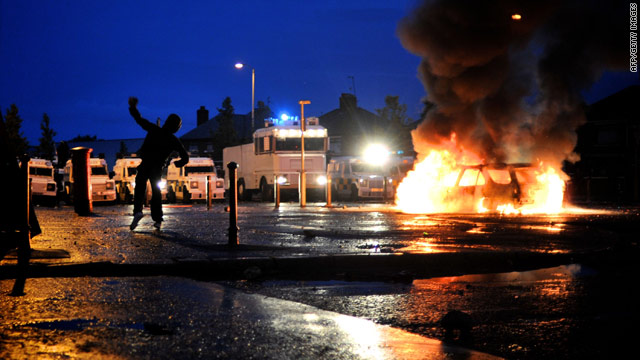By Tristan Simoneau
Impunity Watch Reporter, Europe

- Photo: Cars burn during rioting in Belfast on July 12th. [Source: CNN]
BELFAST, Northern Ireland – On July 11th, riots erupted in Belfast when a Protestant march passed through areas mainly populated by Catholics. Despite the calm in the region since a 1998 peace deal, violence still often breaks out around July 12th as Catholics try to prevent marches. Known as The Twelfth, the holiday has been marred by violence and has been a continuing source of tension between Catholics and Protestants. The date marks Prince William of Orange’s victory over the Catholic King James II at the Battle of the Boyne in 1690. The month of July is the height of the “marching season”, a six-month period in which the pro-British Protestant fraternal organization, the Orange Order, takes to the streets to celebrate the ascension of William of Orange to the British throne. The past decade has seen a gradual decrease of tension between the groups, until this year.
On the night of the 11th, twenty-seven officers were hurt, including three who were shot at close range by a man armed with a shotgun. On July 12th, the day of the march, police had to remove demonstrators who staged a sit-down protest to block the march. Rioting erupted soon afterwards and more than 50 officers were injured. There are reports that on July 13th, four to six shots were fired at police in the mainly Catholic Ardoyne district of Belfast. Many rioters also threw petrol bombs and stones, prompting police to use water cannons to deter the attacks. Now police commanders are saying that the rioting appears to be on the wane after four nights of attacks that have left more than 80 officers wounded. A Belfast deputy commander, Duncan McCausland, said rioting Wednesday night and Thursday morning involved “a substantially smaller group of people.”
Politicians have accused the Irish Republican Army of directing the violence that began Sunday night. British Prime Minister David Cameron condemned the behavior of the protestors as “completely unacceptable” and praised the police for their “bravery and restraint.” Cameron said Northern Ireland’s police force is under local control and is no longer taking orders from London. The Prime Minister also stated “there is no excuse for anyone not to cooperate with the police force.”
The Chief Constable of Northern Ireland, Matt Baggot, has stated that his force is determined to bring those responsible to justice. Five arrests have been made following the violence.
For more information, please see:
CHRISTIAN SCIENCE MONITOR – Northern Ireland riots raise worries about ‘bad old days’ – 15 July 2010
IRISH TIMES – Fourth night of riots in Belfast – 15 July 2010
AP – Police dodge gunfire in 3rd night of Belfast riots – 14 July 2010
BBC – ‘Significant arrests’ promised after Belfast riots – 14 July 2010
CNN – Third night of violence in Belfast – 14 July 2010

